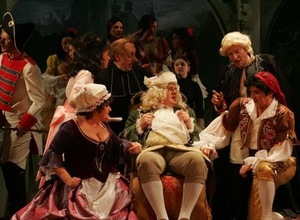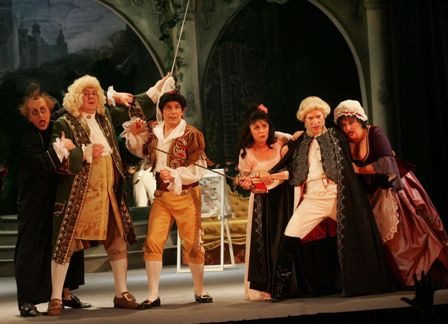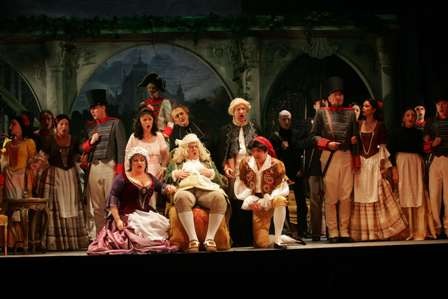FIGARO - HERE, AMBROGIO - THERE 0
Osvaldas Grinius
www.kamane.lt 2007 11 29
Performance "Barber of Seville”. Photos by L.Brundza
In brief: Who is the main character of the opera “Barber of Seville” by Gioachino Rossini? Figaro, Rosina, or Count Almaviva perhaps? One may make a mistake here. The audience of the newest premiere of Kaunas Musical Theatre was almost sure that the silent servant of Doctor Bartolo Ambrogio attracted attention the most.
The premiere of the opera was presented at Kaunas Musical Theatre on November 24 and 25. The performance was created following the traditional interpretation line without searching for some special novelties. It is a colourful and merry spectacle, which does not pretend to be an innovative or modern work. The most conservative chain was the decorations and costumes created by Tatjana Astafjeva – costumes were luxurious and bright, decorations were also rather glaring recreating real settings – a street of Seville, one or another room of Doctor Bartolo.
In addition to traditional mise-en-scenes, the director Gintautas Želvys presented several more interesting solutions. The brightest of them was the overture during which the characters of opera roles were introduced by dance, movement or silent mass scenes. Another interesting point was the prominence given to Ambrogio. The direction of the performance was based on music searching for movement and action places in the notes.
From the musical aspect, the conductor of the performance Aleksandr Sladkovski offered several unusual solutions to listeners as well. Female voices were included into choir scenes of the performance (finale of the second and third act). The conductor matched the music tempo to the possibilities and wishes of soloists. The orchestra of the theatre played in a concentrated manner and reacted well to the demanding and plastic gestures of the conductor. Perhaps more rehearsals with A.Sladkovski would have become useful.
The text of the performance became the biggest surprise. It was clear after two premieres that the creators did not have a clear concept of the text translation and followed old existing versions. The result was rather strange and did not create a solid impression. Moreover, text was not always necessary for gaining favourable attention of the audience – this was proved by the colourful character created by the ballet actor Dainius Bervingis. It was so outstanding that the solo scene of the servant of Doctor Bartolo Berta turned into a duet, in which Ambrogio played the first violin without pronouncing a single music sound.
Doctor Bartolo was one of the characters who was enjoyed the most by the audience. This was determined by the comic features of the character and the wonderful talent of the performer Gediminas Maciulevičius. The soloist mastered the complicated music well and performed certain episodes in a really astonishing manner.
The part of Count’s lover and foster-child of Doctor Bartolo, Rosina, is the dream of a coloratura soprano and the decoration of the repertoire. One of the most complicated solo parts of the opera is at the beginning of the second act. The performers of this role Raminta Vaicekauskaitė and Gitana Pečkytė created a real challenge to themselves by choosing the complicated variant of the aria decorated by coloraturas. R.Vaicekauskaitė mastered the music material without any reproaches, and she acted in a natural and warm manner. The soloist G.Pečkytė also prepared the role with responsibility. Her soprano is strong, has metal shade and she performed the complicated parts with much precision. Moreover, the role becomes her greatly.
One more creative success of the opera is the role of Figaro created by Raimondas Baranauskas. The soloist embodied the youthful and energetic image of the barber. The sonorous baritone of the performer, exact and strong high notes, logically nuanced acting received recognition of the audience. Figaro was acted by Mindaugas Gylys in the second premiere – he moved freely on the stage and sang in baritone of lush timber. Still, there were some inaccuracies in the musical text of the singer, high notes were not performed very exactly.
In general, it is possible to state that the fifth staging of the opera “Barber of Seville” at Kaunas Musical Theatre is the strategic step of the theatre director. Even though the performance does not aspire to conquer the heights of theatre world by its scenography and director’s decisions, it should correspond the taste of Kaunas audience. It is a serious opus from the musical point of view mobilising all the forces of the troupe and making it rise from the sea of entertaining stage genres.











